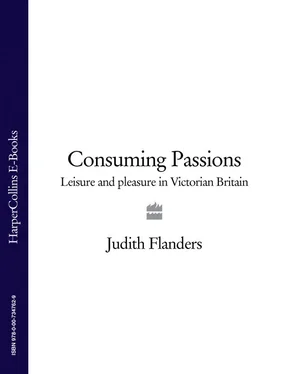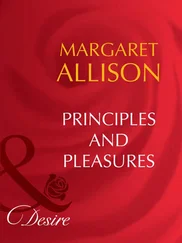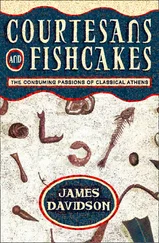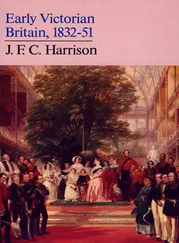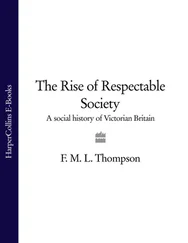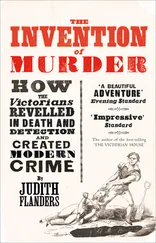The Official Descriptive and Illustrated Catalogue , reading which was as close as many visitors would get to thinking about the purpose of the fair, claimed in its introduction to be ‘a book of reference to the philosopher, merchant and manufacturer’. Thus, in its own view, it was an educational tool—one that would give instruction to those exhibiting, and also to those many manufacturers in the same field who were not providing exhibits. The catalogue would show these people examples of the best work of their competitors, for them to strive towards. Then, for the many visitors, the catalogue would also explain the new world of technology and design, in layman’s language, to improve their taste. By this means, the customers would be led to demand more of the manufacturers, and this heightened demand for quality would in turn improve the supply.
That was the idea. Carrying it out was another matter. The planning of the exhibits, both in the catalogue and in the actual display halls, had been a mixture of overlapping responsibilities shared between the centralized and local organizations. The local committees had selected the goods to be displayed from their regions or cities, with the barest guidance, in the form of a preliminary outline, from the commission. Once the items were chosen, how they were laid out, and the organizational structure of the hall, were entirely the province of the central body. The planners had originally wanted the Exhibition to represent a schematic re-creation of their thirty-section outline, laying out the state of industrial knowledge before the visitors in map-like form, walking them through the processes by which goods were transformed from raw material, via labour, to finished products. But both because it was not the commission which was making the initial selections and because of the technical requirements of the building, nothing but lip service could ultimately be paid to this didactic aim. The local committees had not necessarily chosen exhibitions that showed each of the processes, and, even when they had, there were power sources in only one part of the north-west axis of the halls, so all the industrial machinery had to be set up there. Then it was realized that the floor of the upper galleries could not bear the weight of heavy machinery, so they became the logical place for lightweight manufactured goods. The central axis or nave, as the main walkway of the Crystal Palace became known, ended up displaying most of the consumer commodities.
The crowds were required to follow specific routes and not able to wander at will. Rather in the way that out-of-town superstores such as Ikea process their customers past high-priced goods or seasonal overstocks, the route down the nave of the Crystal Palace ensured that all visitors passed by the highly finished consumer goods—the goods that were the most superficially attractive, the most entertaining, and the least educational. While the Exhibition stressed abundance and choice—in Prince Albert’s words, ‘The products of all quarters of the globe are placed at our disposal, and we have only to choose’—in fact, the choice had been made already, by the selection committee, by the display committee, and by those guardians of public order who decreed which route the consumers were to take. The visitor had only limited choice about where to go, or what to see.
Henry Mayhew’s comic novel of the Great Exhibition, 1851: or, The Adventures of Mr and Mrs Sandboys and Family, Who Came Up to London to ‘Enjoy Themselves’, and to See the Great Exhibition , opened with a paragraph describing the foreigners going round the Crystal Palace. It began, ‘The Esquimaux had just purchased his new “registered paletot” [a loose, coat-like cape] of seal-skin…The Hottentot Venus had already added to the graceful ebullitions of nature, the charms of a Parisian crinoline .’ 33The humour here is of the simple ‘look-at-the-funny-natives-encountering-civilization-for-the-first-time’ type, but reading this passage today what is noticeable is Mayhew’s unconscious acceptance of the purpose of the Exhibition: the display of fashionable commodities and their subsequent acquisition by the visitors. For it was acquisition that was beginning to hold sway at the Great Exhibition. Horace Greeley had already linked acquisition specifically to an increase in moral good: ‘Not until every family shall be provided with a commodious and comfortable habitation, and that habitation amply supplied with Food and Fuel not only, but with Clothing, Furniture, Books, Maps, Charts, Globes, Musical Instruments and every other auxiliary to Moral and Intellectual growth as well as to physical comfort , can we rationally talk of excessive Production’ (my italics). 34Now it was not merely food and shelter that were considered necessities, but also education, the arts, and physical comfort more generally. Greeley saw clothes, furniture, books, maps and musical instruments all as necessities, all as ‘auxiliaries’ to ‘Moral and Intellectual growth’.
This was a culmination of a gradual process. Over the previous century and a half there had been an enormous change in the way people lived. The architect John Wood, as early as 1749, had listed a number of improvements that had taken place in domestic interiors over the previous quarter-century—improvements that were taken for granted in homes of moderate prosperity by the time he wrote. Cheap floorboards and doors had been replaced by deal and hardwoods and the bare floors covered with rugs, while mahogany and walnut furniture had replaced the previously more customary oak; *rough plasterwork was now hidden behind elegant wood panelling; stone chimney-pieces were replaced by marble, and iron fixtures by brass; while cane and rush chairs were rejected in favour of upholstered leather and embroidered ones. 36Yet even the low base of the 1720s that Wood was looking back to had already seen a big step forward to modern notions of comfort. Indeed, the word ‘comfort’ in the sense of physical and material well-being came into use only in the last third of the eighteenth century. Previously ‘comfort’ had a spiritual and emotional meaning—succour, relief or emotional support. It was in the early nineteenth century that ‘comfort’ in the modern sense became commonplace, and yet only a few decades later Horace Greeley thought it natural to list it as a necessary component of a happy life.
It is hard, in our age of material possessions, and given the stereotypical ‘overstuffed’ image of the late Victorian period, to appreciate from what a bare minimum the acquisition of possessions began. As late as the 1690s, something as basic to us as a utensil to hold a hot drink—that is, a cup—was ‘extremely rare’ even in prosperous households. A mere thirty years later, by 1725, ‘virtually all’ of these households had some. 37We don’t really have any idea of what the poorest in the seventeenth century owned—they died leaving no records. But of those who had enough goods that it was considered worth drawing up an inventory on their deaths, it is illuminating to compare one James Cushman, who died in 1648, with the poorest man listed in the inventories of Sedgley, Staffordshire, ninety years later. Cushman left, in his kitchen, ‘one small iron pott’, ‘a small scillite [skillet]’ and ‘one small brass scimer [skimmer]’. The deceased in Sedgley in 1739 owned, by contrast, a fire shovel, a coal hammer, a toasting iron, a bellows, a copper can, wooden furniture, a ‘tun dish’ or funnel, scissors, a warming pan, a brass kettle, bottles, earthenware, two iron pots, a pail, a ‘search’ or sieve, two old candlesticks, a kneading tub, two barrels, two coffers, a box, some trenchers, pewter, a brass skimmer, a brass basting spoon, an iron meat fork, a tin ‘calender’ or colander, and more. 38A similar increase in the quantity of goods can be found among those with more disposable income: in a survey of 3,000 inventories taken on the death of the head of the household in more prosperous homes, in 1675 half owned a clock; by 1715, 90 per cent of households did. 39This continuous growth in the number of possessions, this concern with the acquisition of goods for the home, was marked enough to be gently satirized in George Colman and David Garrick’s 1784 play The Clandestine Marriage , in which one character announces, ‘The chief pleasure of a country-house is to make improvements.’ 40
Читать дальше
